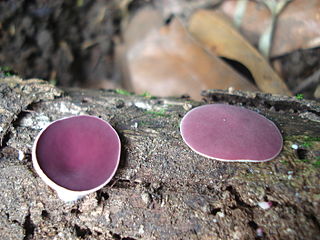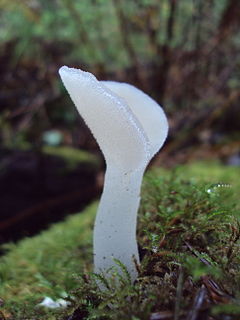
Fomitopsis betulina, commonly known as the birch polypore, birch bracket, or razor strop, is a common bracket fungus and, as the name suggests, grows almost exclusively on birch trees. The brackets burst out from the bark of the tree, and these fruit bodies can last for more than a year. Technically, it is an edible mushroom, with a strong, pleasant "mushroomy" odor but a bitter taste. The velvety cut surface of the fruit body was traditionally used as a strop for finishing the edges on razors, and also as a mounting material for insect collections.

Boletus is a genus of mushroom-producing fungi, comprising over 100 species. The genus Boletus was originally broadly defined and described by Carl Linnaeus in 1753, essentially containing all fungi with spores. Since then, other genera have been defined gradually, such as Tylopilus by Petter Adolf Karsten in 1881, and old names such as Leccinum have been resurrected or redefined. Some mushrooms listed in older books as members of the genus have now been placed in separate genera. These include such as Boletus scaber, now Leccinum scabrum, Tylopilus felleus, Chalciporus piperatus and Suillus luteus. More recently, Boletus has been found to be massively polyphyletic, with only a small percentage of the over 300 species that have been assigned to Boletus actually belonging there and necessitating the description and resurrection of many more genera.

Chaetomium is a genus of fungi in the Chaetomiaceae family. It is a dematiaceous (dark-walled) mold normally found in soil, air, cellulose and plant debris. According to the Dictionary of the Fungi, there are about 95 species in the widespread genus.

Ganoderma, a genus of polypore fungi in the family Ganodermataceae, includes about 80 species, many from tropical regions. Because of their genetic diversity, use in traditional Asian medicines, and potential in bioremediation, they are an important genus economically. Ganoderma can be differentiated from other polypores because they have a double-walled basidiospore. They are sometimes called shelf mushrooms or bracket fungi.

Hydnellum is a genus of tooth fungi in the family Bankeraceae. Widely distributed in the Northern Hemisphere, the genus contains around 40 species. The fruitbodies of its members grow by slowly enveloping nearby bits of grass and vegetation. There is great variability in the form of Hydnellum fruitbodies, which are greatly influenced by environmental conditions such as rainfall and humidity, drying winds, and temperature. They are too tough and woody to eat comfortably. Several species have become the focus of increasing conservation concern following widespread declines in abundance.

Inonotus is a genus of fungi in the family Hymenochaetaceae. The genus, described by Petter Karsten in 1879, is estimated to contain about 80 species sensu lato and 30 species sensu stricto.

Phellodon is a genus of tooth fungi in the family Bankeraceae. Species have small- to medium-sized fruitbodies with white spines on the underside from which spores are released. All Phellodon have a short stalk or stipe, and so the genus falls into the group known as "stipitate hydnoid fungi". The tough and leathery flesh usually has a pleasant, fragrant odor, and develops a cork-like texture when dry. Neighboring fruitbodies can fuse together, sometimes producing large mats of joined caps. Phellodon species produce a white spore print, while the individual spores are roughly spherical to ellipsoid in shape, with spiny surfaces.

Hydnellum aurantiacum is an inedible fungus, commonly known as the orange spine or orange Hydnellum for its reddish orange or rusty red colored fruit bodies. Like other tooth fungi, it bears a layer of spines rather than gills on the underside of the cap. Due to substantial declines in sightings, this species is listed as critically endangered in the United Kingdom.

Climacodon is a widespread genus of tooth fungi in the family Phanerochaetaceae.
Dubitatio is a fungal genus in the family Massariaceae. According to the 2007 Outline of Ascomycota, the placement of the genus in this family is uncertain. This is a monotypic genus, containing the single species Dubitatio dubitationum, found in temperate South America.
Ascophanus is a genus of fungi in the Ascobolaceae family. The genus has a widespread distribution, and contains 20 species, most of which grow on dung.

Oudemansiella is a genus of fungi in the Physalacriaceae family. According to the Dictionary of the Fungi, the genus contains about 15 species that are widely distributed in tropical and temperate regions. Yang and colleagues revised the genus in a 2009 publication, describing several new species and several varieties. They classified species in the genus into four sections based on the structure of the cap cuticle: Oudemansiella, Mucidula, Dactylosporina, and Radicatae.

Ripartites is a genus of fungi in the Tricholomataceae family. The genus has a widespread distribution and contains five species. Species in Ripartites have small, round to subglobose spores which are yellowish-brown and ornamented. Macroscopically, they resemble Clitocybe. Ripartites was circumscribed by Petter Karsten in 1879.

Ischnoderma is a genus of polypore fungi. Species in the genus have dark brown and tomentose fruit bodies that become darker brown to black and smooth when mature. The genus, widespread in temperate regions, contains an estimated 10 species.

Hapalopilus is a genus of poroid fungi in the family Polyporaceae. The genus is widely distributed. The generic name combines the Ancient Greek words ἁπαλός ("tender") and πιλος ("cap"). Hapalopilus was circumscribed by Finnish mycologist Petter Adolf Karsten in 1881.

Phillipsia is a genus of fungi in the family Sarcoscyphaceae. There are about 17 species in the genus, which collectively have a widespread distribution in subtropical and tropical areas. The genus was circumscribed by Miles Joseph Berkeley in 1881. The generic name honours Wales-born English botanist William Phillips (1822–1905).

Pseudohydnum is a genus of fungi in the order Auriculariales. The genus, first described by mycologist Petter Adolf Karsten in 1868, has not been classified with certainty into a family, and so is incertae sedis with respect to familial placement. Pseudohydnum is monotypic, containing only the widely distributed species Pseudohydnum gelatinosum.

Podostroma is a genus of fungi in the family Hypocreaceae. It was circumscribed by the Finnish mycologist Petter Karsten in 1892. The genus contains 11 species that collectively have a widespread distribution.

Tuber is a genus in the Tuberaceae family of fungi. It includes several species of truffles that are highly valued as delicacies. According to a standard reference text, the widespread genus contains 86 species.

Amphinema is a genus of corticioid fungi in the family Atheliaceae. The widespread genus contains six species.



















